What is a dumbbell
What is a dumbbell
– and three common mistake when training with dumbbells
In this article you will learn about what dumbbells are, what different types of dumbbells there are, how adjustable dumbbells work – and the benefits of using them in your training routine.
What is a dumbbell
A dumbbell? What is a dumbbell? And why is it called a “dumb” bell? As you’ll learn today, the name has nothing to do with being foolish or stupid. In fact, we would argue that anyone using a dumbbell is a sweat-loving genius. Using a dumbbell means you are working out (a dumbbell is training equipment, after all), and when you are training, you are taking care of your body and mind – and that is smart.
In this article, you will learn what a dumbbell is, the different types that exist, how to use them and how to choose the right one for you.
- At the end of the article, you’ll get a bonus: 5 common mistakes when using dumbbells. So let’s go!
Handheld training equipment
A dumbbell is a piece of training equipment that you hold in your hand. Commonly used in pairs but also individually. Dumbbells fall into the category of free weights, meaning that no machine or cable is attached to them.
The construction of a dumbbell is a bar with weights on each side. The weight of a dumbbell can vary from a light 0.5 kg to a lofty 50 kg, which makes it a truly democratic piece of exercise equipment. It works for beginners and experts and opens the door to a world of different exercises for your entire body. Plus, you can train big as well as small muscles with dumbbells.
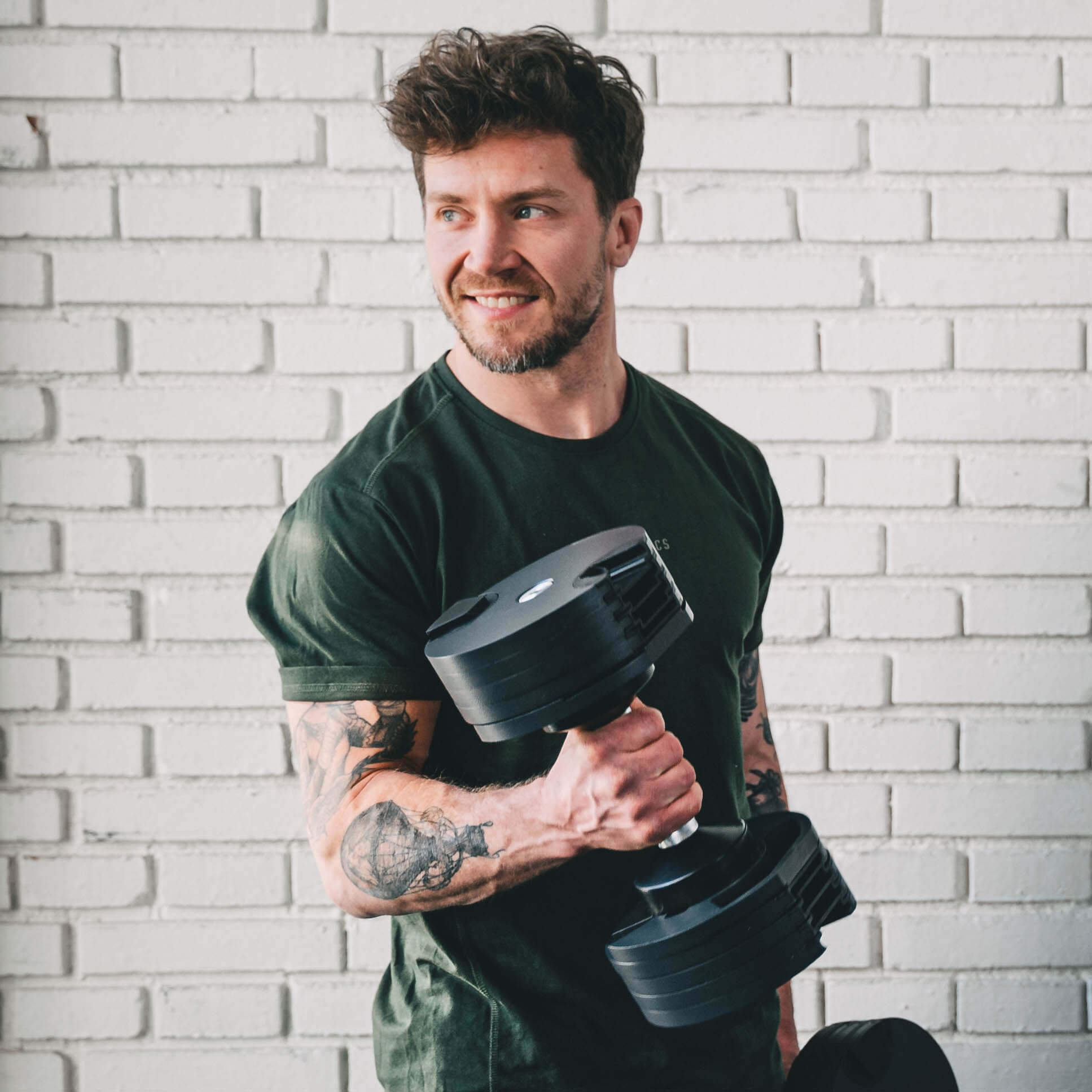
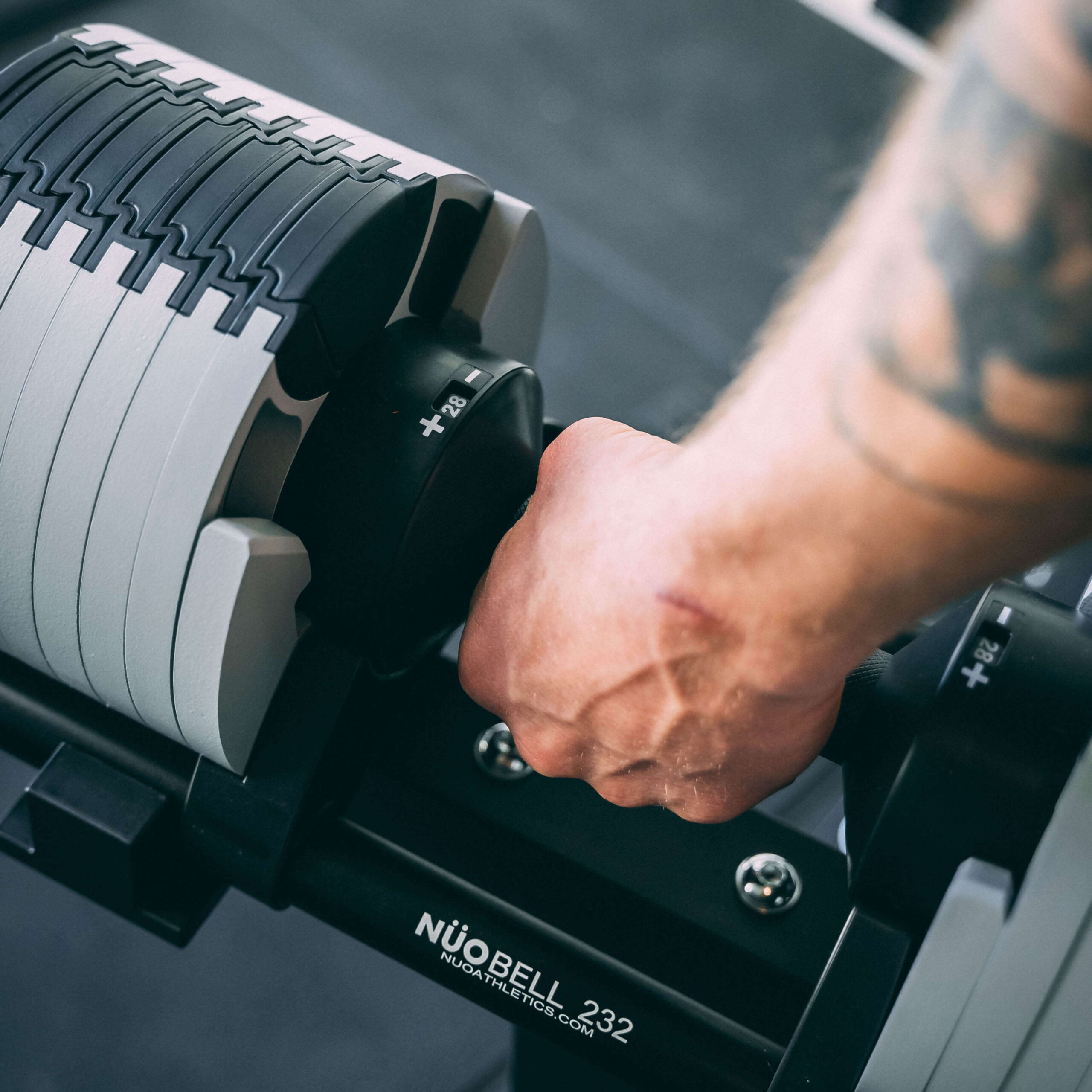
Dumbbells are used to
- Get stronger
- Build muscles
- Be more toned
- Increase endurance
And it goes without saying that training will improve your health and potentially prevent diseases like heart disease and stroke. According to the Center for Disease Control and Prevention (CDC) just 150 minutes of moderate workout per week is enough to reduce the risk of these conditions. Additional physical activity can reduce the risk even more. What’s not to like?
There’s an ocean of exercises you can perform with dumbbells. For some, you use two dumbbells and work the left and right sides simultaneously, such as a bicep curl or shoulder press. But there are lots of fun and effective exercises where only one dumbbell is used as well, like dumbbell snatches and Russian twists. And if you think that last one sounds a bit like a cocktail, top marks for getting into the spirit of exercising with a playful mindset.
High flexibility
Two dumbbells, all you need
Dumbbells might look simple, but don't let that fool you. Despite their no-frills appearance, dumbbells could be the only exercise equipment you need, the perfect partner for quick and complete workouts alike. With a bit of imagination, there's no end to the variation of exercises you can perform with dumbbells, and that makes a dumbbell a great training companion. However, you will need different weights depending on your target muscle group. For example, legs and back require heavier weights than arms and shoulders.
Increase the weight in small steps. Really?
If you have several pairs of fixed dumbbells or one pair of adjustable ones, you have what it takes to progress, get stronger, more toned, and increase your endurance. Plus, as you progress, you can increase the weight in small steps to meet and match your improved strength.
"Increase the weight in small steps? Why not go heavy each time I add weight?" you might ask. "Wouldn't that be better and more effective to get stronger?"
Actually, no. To get stronger and at the same time reduce the risk of injuries, it is recommended to add weight in increments of 1,5-2 kg. So if muscle mastery is your goal, it pays to be less Rocky and more Remy from Ratatouille!
Material and grip
To answer the question ‘What is a dumbbell?’, we also need to talk about the material and grip. Most of today’s modern dumbbells are made of solid iron or treated steel, sometimes with a rubber or neoprene coating. The coating is there to protect the inner material and to make the dumbbell more comfortable to hold. Sweat makes things slippery, after all.
Plastic is sometimes used, but only for dumbbells of lower weight. Since plastic is significantly lighter per cm3, heavier dumbbells are not made from plastic, as they would be far too bulky. One benefit of plastic dumbbells, as opposed to those made of other materials, is that they are cheaper, but on the downside, they tend to break more easily.
A dumbbell made of iron or steel is thus far more durable than the same made from plastic. So even though a plastic version isn’t necessarily bad, you can be more confident that a steel or iron version will withstand drops (intentional or unintentional) or other accidents better.
Grip
The grip of the dumbbell is a small but super important detail, especially if you perform more strenuous workouts where your hands will get sweaty. No one needs a wavering dumbbell when they're trying to take things up a notch! And to that end, stability is usually assured by some kind of engraved pattern on the handle. Although this could differ per model, the function is the same.
Plastic dumbbells will be more slippery when wet (great Bon Jovi album, not so great if you're exercising) compared to dumbbells made of steel or iron. The latter often have a knurled pattern on the handle to increase the grip, which is a great benefit when it comes to holding the dumbbell steady.
Why is it called a dumbbell?
Contrary to how it sounds, the name has nothing to do with being dumb. "Dumb" in this case means to mute or silent. It refers to (church) bells that are unable to produce sound. Hence, 'dumb bells'.
In the sixteenth century, athletes in England lacked dedicated and proper workout equipment, so they trained with what they had: handheld bells where they removed the metal part that made them ring (the clapper), so the bells made no sound. Kind of understandable that it would be a bit disturbing and loud to exercise with the clapper still in the bell.
As athletes started to evolve the dumbbells towards the shape we know today, they kept the name.
And that, my friends, is how the dumbbell got its name.
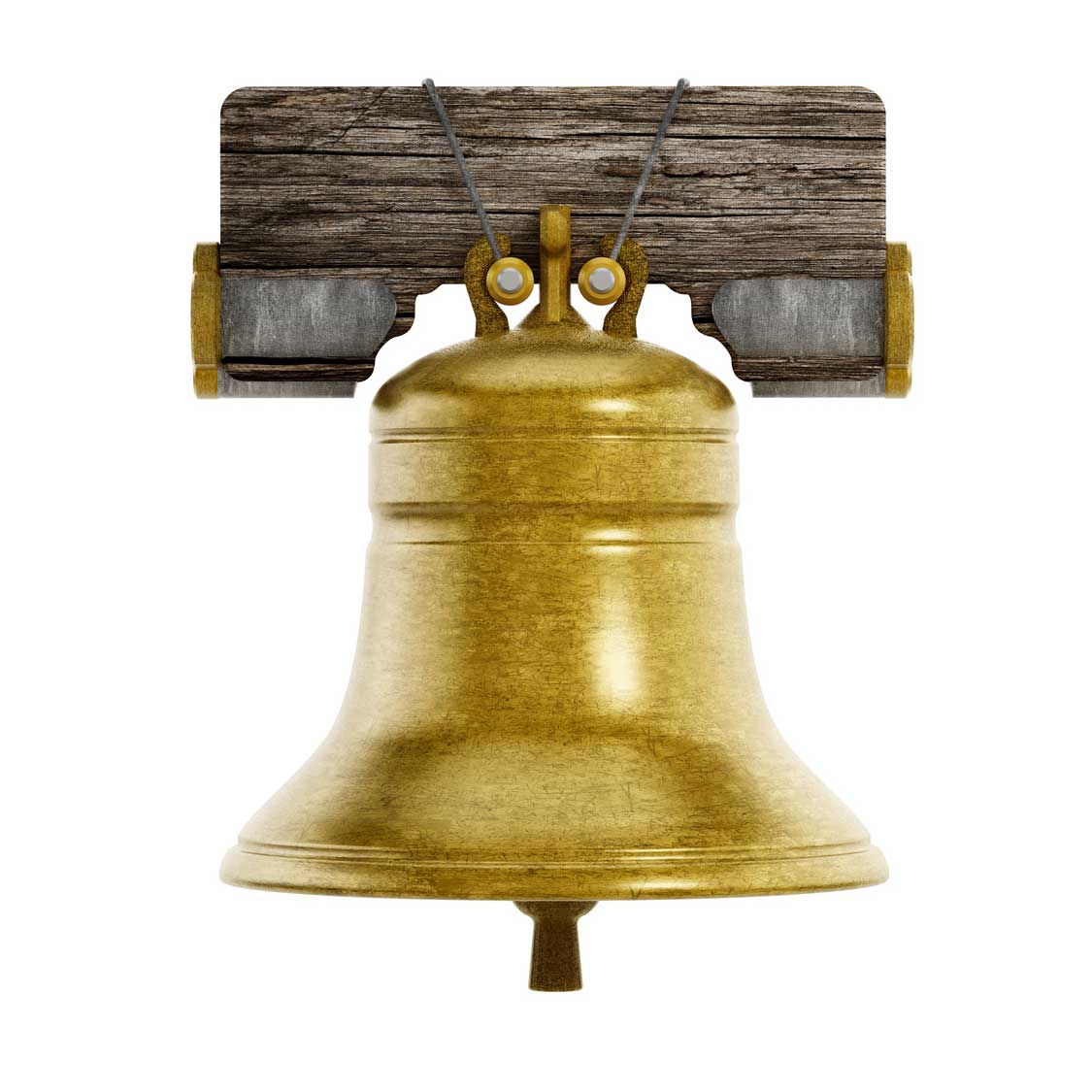
10 benefits of using dumbbells
When discussing what a dumbbell is, it makes sense to talk about the benefits of using a pair in your workout. And as it turns out, there are lots of "positive progressions" to gain in your training from using dumbbells. is, you obviously want to know about the benefits of using them in your workout. There are lots of “things” to gain in your training.
1. Build muscles
Which improves your heart health. Dumbbells are excellent for strength training and building muscles. To build muscles and to get stronger, you need to use resistance that is heavy enough for you and to increase the weight in small steps continuously. That's when you work with progressive overload, meaning you gradually increase one variable in your training. For example, it could be to increase:
- the weight
- the number of repetitions per set
or to work at a slower tempo when performing your exercises.
With dumbbells, it's easy to work according to progressive overload and add weight exactly when needed, with the small increments required to build muscles.
Note! Did you know that building muscles can help to improve heart health?
Improve your heart health
We usually think of cardio as the most efficient type of exercising for heart health benefits, but strength training has its place too. Working on your muscle strength can reduce cardiovascular disease risk by 17%, according to a study in Medicine and Science in Sports and Exercise (2017) performed on more than 35.000 women.
The study also showed a reduced risk of 30% for type 2 diabetes when participating in any strength training – and partaking in both strength training and aerobic activity is associated with less risk for both of the above conditions, compared to participation in aerobic activity only.
How many reps?
If your goal is to build muscle mass and strength, aim to use moderately heavy dumbbells, meaning a weight you can lift 8–12 reps, doing 3–5 sets.
To achieve maximum strength, use heavy dumbbells and perform fewer reps in each set: 5 or fewer reps in 5 sets.
Regardless of the number of reps, the last one should always be so difficult that you can't perform one more rep. Therefore, you increase your weight when you have reached a level where you can do 2–3 additional reps.
2. Increase your muscular endurance
To lift lighter dumbbells, but with more repetitions in each set, the idea is to train the ability of your muscles to carry out the motion for an extended period without getting tired. Aim to do as many as 20 reps for 3-6 sets.
Endurance training is an integral part of your training, as it gives you the ability to perform well during extended periods in your workout, but also to make your everyday life easier because you will stay energized for longer when carrying out daily activities. And who doesn't want more energy?
3. Burn fat
Strength training increases your heart rate, and you burn fat when your heart rate increases. But note that to burn fat, you need to consider one more parameter: food. 80% of your weight loss results come from what you eat.
The simple truth about weight loss is that you must use more calories than you eat. A healthy way to burn fat is to do it at a pace that is good for your body, not too fast. A quick-fix weight loss won't last in the long run, and when you stop your diet, you will likely gain all the weight you lost.
Why? Because during your aggressive fat-burning period, your body is set to starving mode, and when you start to eat "normal" again, your body will store all the calories it can, turning them into fat. There's also a high risk of falling back to the old eating habits that got you that extra weight in the first place.
Combine workout and healthy eating
How to eat to burn fat is a chapter of its own, but our top tip is to find a healthy way to eat to burn fat in combination with exercise. There are endless studies that show how a combination of healthy eating and exercise is the most effective way to burn fat and take care of your health.
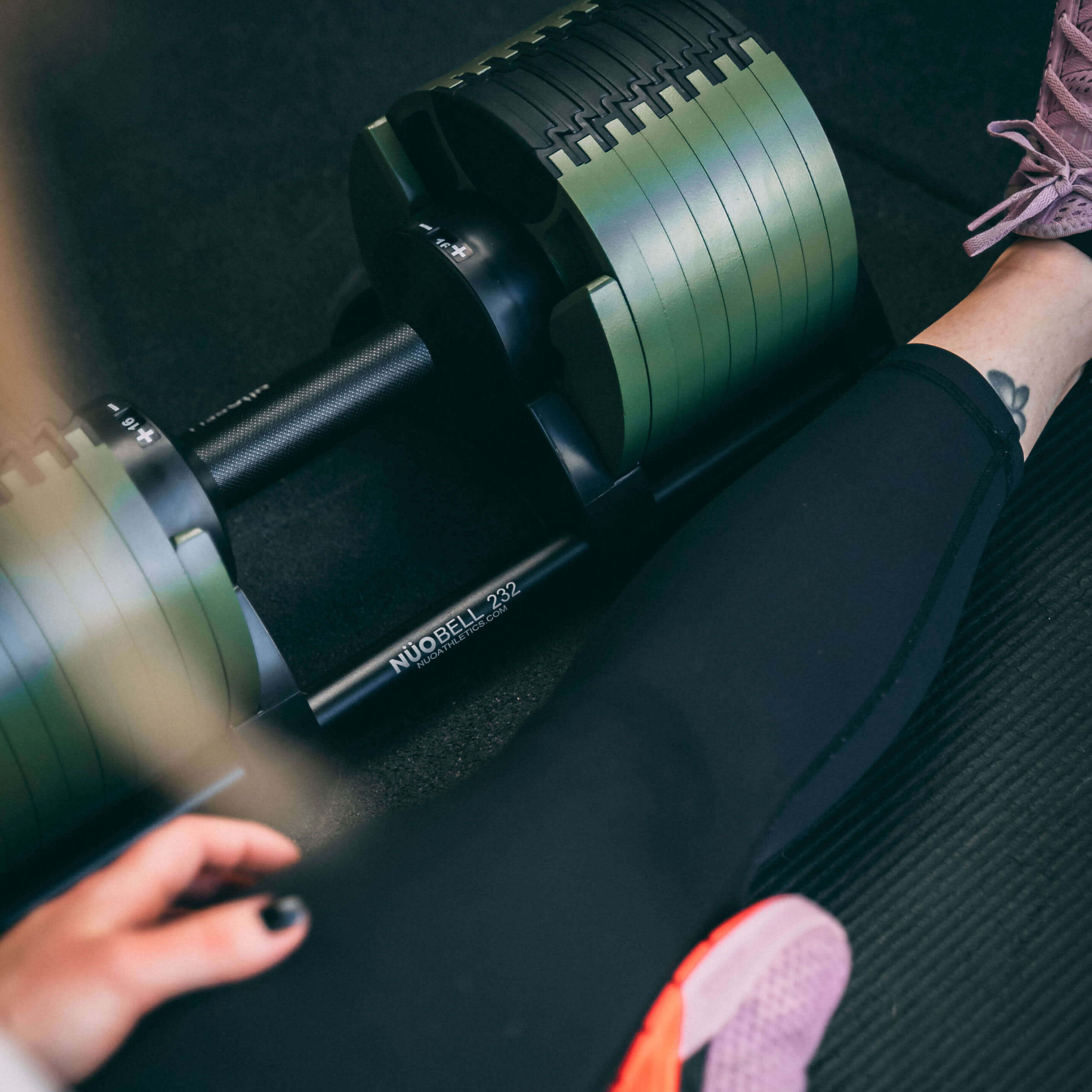
Use your common sense
When you have reached the desired weight or body figure, find a healthy way of eating that works today, tomorrow and the day after. Not only for a limited time. You might have to adjust how you look at "everyday eating", but it will be worth it. Again, if eating got you overweight in the first place, you need to adjust that way of eating permanently.
Note that this doesn't mean you can never eat a pizza again. It's more about common sense. So, as a rule of thumb, if 80% of the time you eat healthy, and 20% of the time you eat whatever you want, you'll be in the ballpark.
4. Challenges not only your strength, but also your balance
One of the many upsides of working out with dumbbells is that it will require more stability since you don't have the same support as a weightlifting machine. The unsupported nature of dumbbells challenges your balance and, as a result, will activate more of your muscle fibers, increasing your balance.
A study in Bioengineering (Basel) in June 2022 showed that dumbbells are the best alternative for beginners when doing squats because the dumbbells help to improve stability.
5. Eliminates imbalances on left or right side
If one side is weaker than the other, the stronger side can't support the weaker side in a dumbbell workout. As opposed to a weightlifting machine - say, a shoulder press machine - where the stronger side can compensate for the weaker and take on more of the load.
6. Perform whole-body workout
Dumbbells may be one of the most complete exercise equipment there is: with dumbbells, only you can perform whole-body workouts. Each muscle group has a big variety of exercises to do with dumbbells.
7. Easy to use
Dumbbells are easy to use. There's nothing complicated about them: just take them in your hands and start your workout.
- Pay attention to how the exercise should be carried out to reduce the risk of injury.
8. Easy to improve
As you get stronger, ramp up to the next level of weight. And then the next, and then the next. Boom! You're a tiger!
9. From rehab to heavy strength training
Since the weight span of dumbbells is agile and wide, you can go from light 0,5 kg weights up to to a loaded 50 kg, and:
- perform rehab exercises with light weights
- work on your endurance
- perform cardio-based HIIT-sessions
- lift heavy to build strength
- perform muscle gaining sets with constantly heavier weights
10. Fits both beginners and experts
Dumbbell training is a great option for both beginners and pro athletes. For someone who has just started working out, knowing where to start and what exercises to perform could feel overwhelming. But working out with dumbbells is easy. There are lots of simple-to-perform exercises that are neither too time-consuming nor require too much space yet are still very effective and will give you a great workout.
On the other hand, pro athletes can also find significant challenges in dumbbell workouts since heavy weights and a vast range of different exercises are available.
Different types of dumbbells
There are more parameters to the initial question; What is a dumbbell? There are different kinds of dumbbells; mainly two different types:
- fixed
- adjustable
You might want to give it some thought before deciding which type that will be the best match for you. As the names imply, the main difference with the two types is whether the weight on the dumbbell is fixed or if it’s possible to adjust it.
Fixed dumbbells
Fixed dumbbells are the ones you usually see at every commercial gym lined up in long rows, with options spanning from light to seriously heavy. And with so many options, there is a suitable weight for everyone and every exercise. Plus, the fact that there are so many separate dumbbells means that many people can use weights at the same time, which is a necessity for any commercial gym. However, a complete range of fixed weights requires a lot of space - not usually an issue for a gym, but it’s something to consider when getting dumbbells for your home.
As mentioned before, fixed dumbbells are hard-wearing. You can throw or drop them on the floor, more or less any way you like, without damaging the dumbbell. However, the floor might not be so lucky unless you’re at a gym with a dedicated weightlifting floor or have the same specific floor at home. Otherwise, watch out!
Fixed dumbbells are also suitable for home training. But if you want a complete range to perform whole-body workouts, be prepared to give up some space, as you may need as many as 16 pairs of dumbbells (32 pcs). So unless you’re willing to show the dog the door, you may need to consider adjustable dumbbells. However, if you have limited space but plan to use dumbbells for a limited number of exercises, fixed can be the right choice.
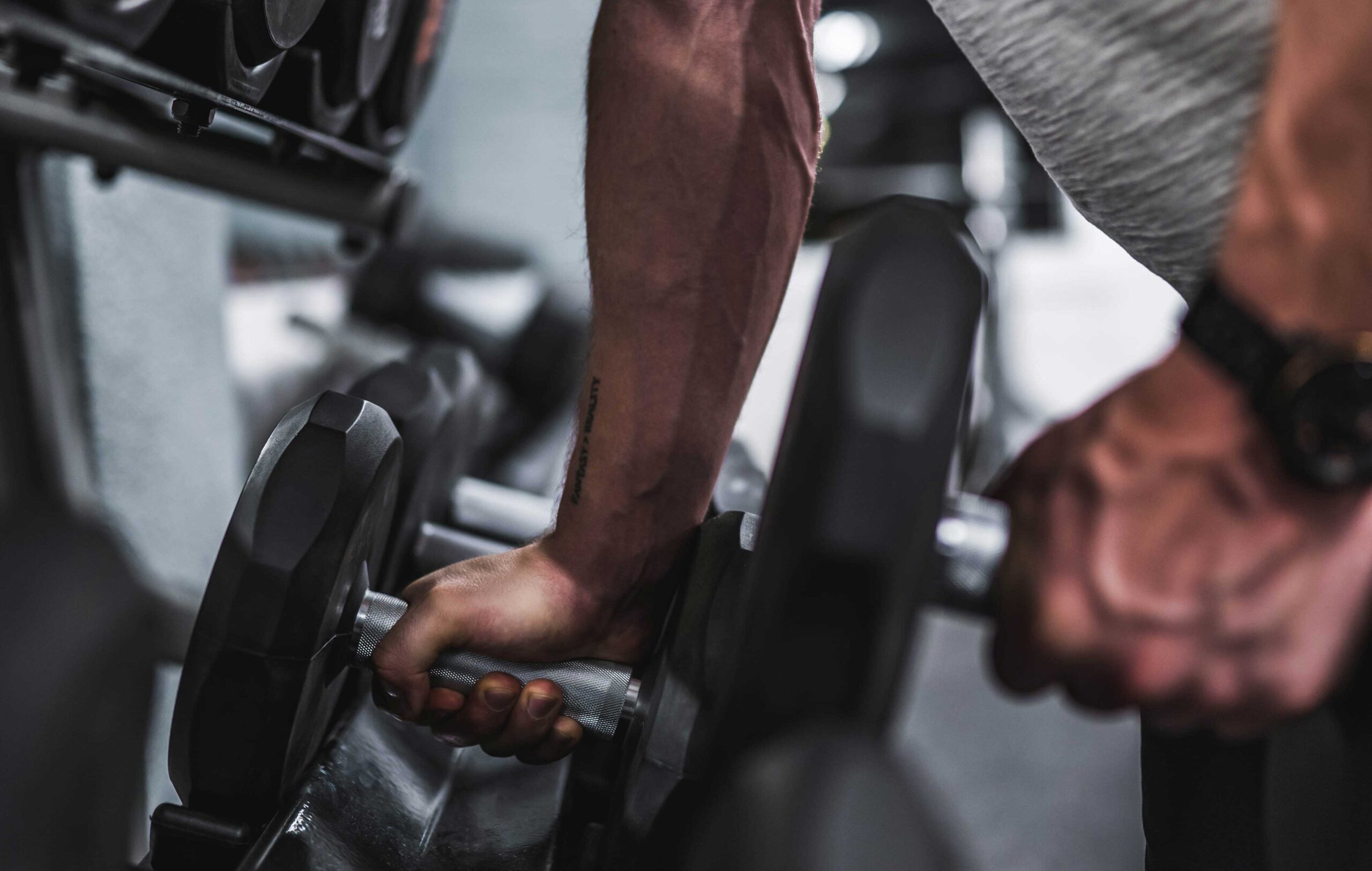
Adjustable dumbbells
As opposed to a fixed dumbbell with a set weight per dumbbell, an adjustable dumbbell allows you to change weights as you work out.
You can add and remove weights as you wish, generally with increments at 1,5-2 kg. Max and minimum weight of the dumbbells depends on the model, but they usually span 2–30/40 kg. All of which might sound a bit confusing if you haven’t heard about adjustable dumbbells before. How can one dumbbell change its weight? It turns out, pretty easily!
Side note: it's worth noting that different types of adjustable dumbbells may not operate in the same way and may be more or less easy/smooth to adjust and use.
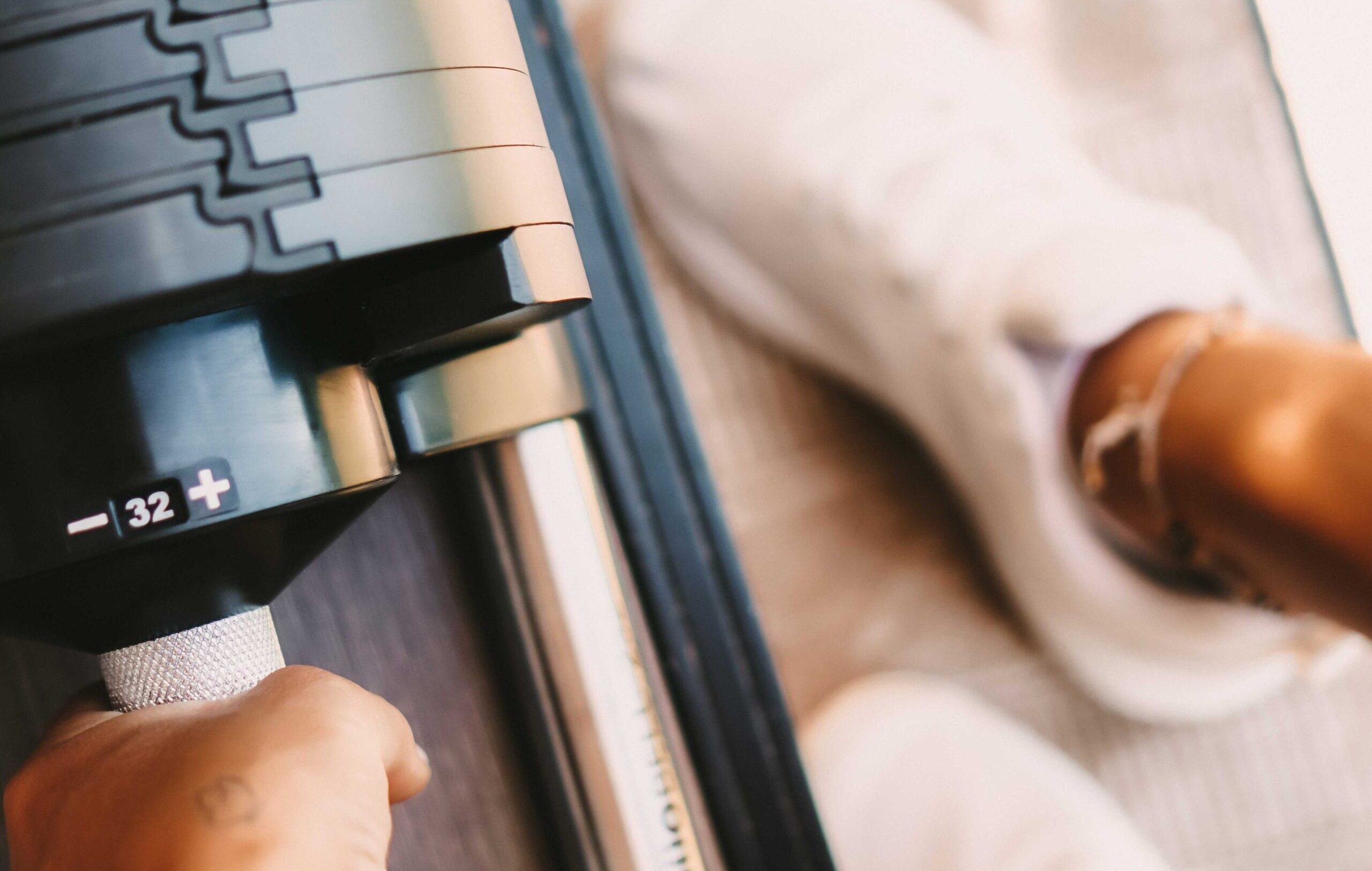
Different kinds of adjustable dumbbells
1. Knob
The simplest version of an adjustable dumbbell consists of a bar with loose weight plates and knobs on the sides. The knobs are what hold the weight plates in place. To add or remove weights, unscrew the knobs and put on the desired amount of weight plates. A bit time-consuming but totally doable.
+ cheap
+ durable
+ easy to use
- takes time to change weights
- the plates can rattle
- max weight is limited; the length of the bar in combination to what size of weight plate that makes sense to use, limits the max load.
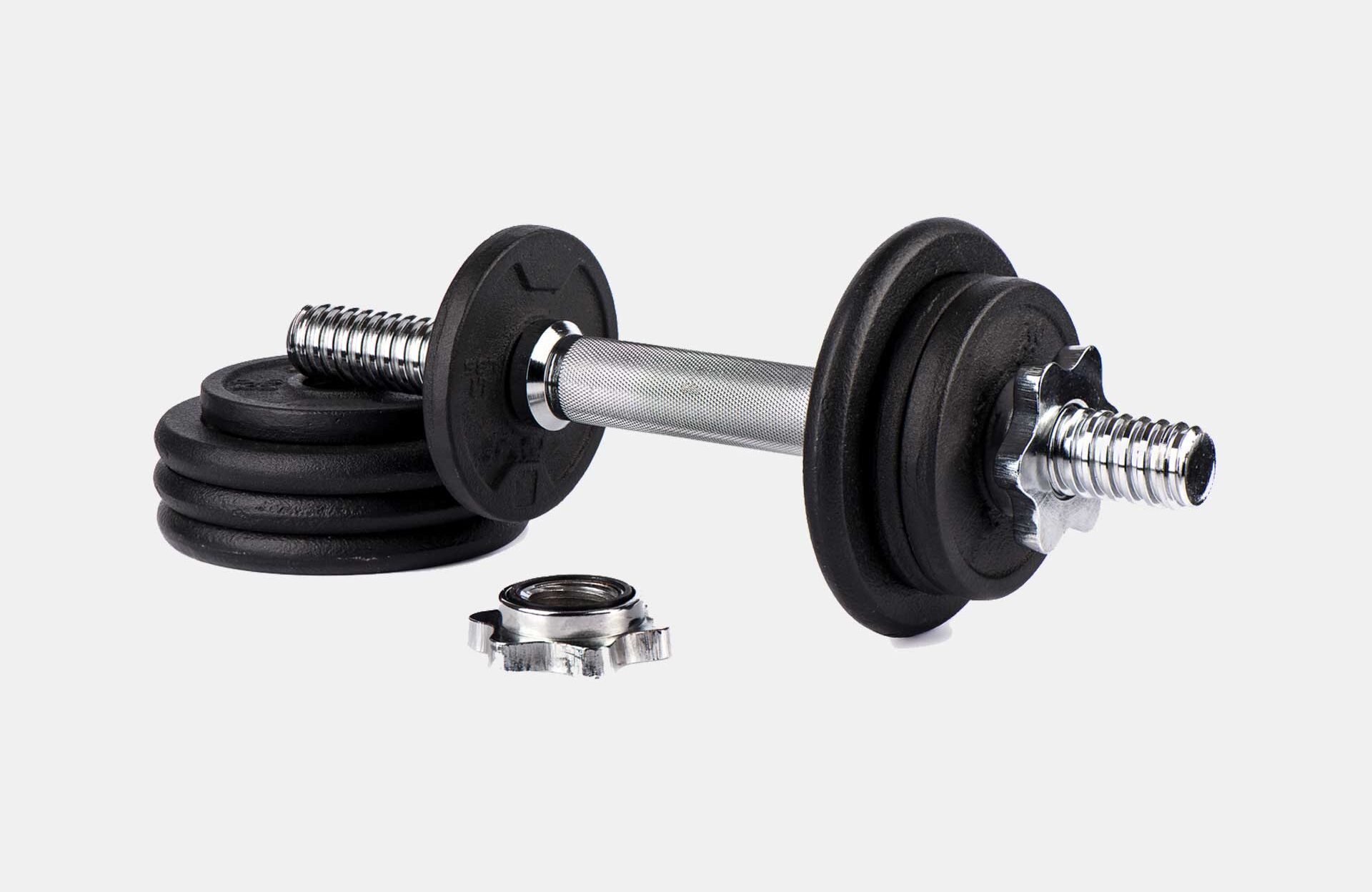
2. Dial
Another version takes a different approach by using a dial on each side of the bar. To adjust the weight, put the dumbbell in its rack and turn the dial on both sides.
+ easy to use
- Some of these versions are a bit clumsy and could potentially feel a little awkward to use
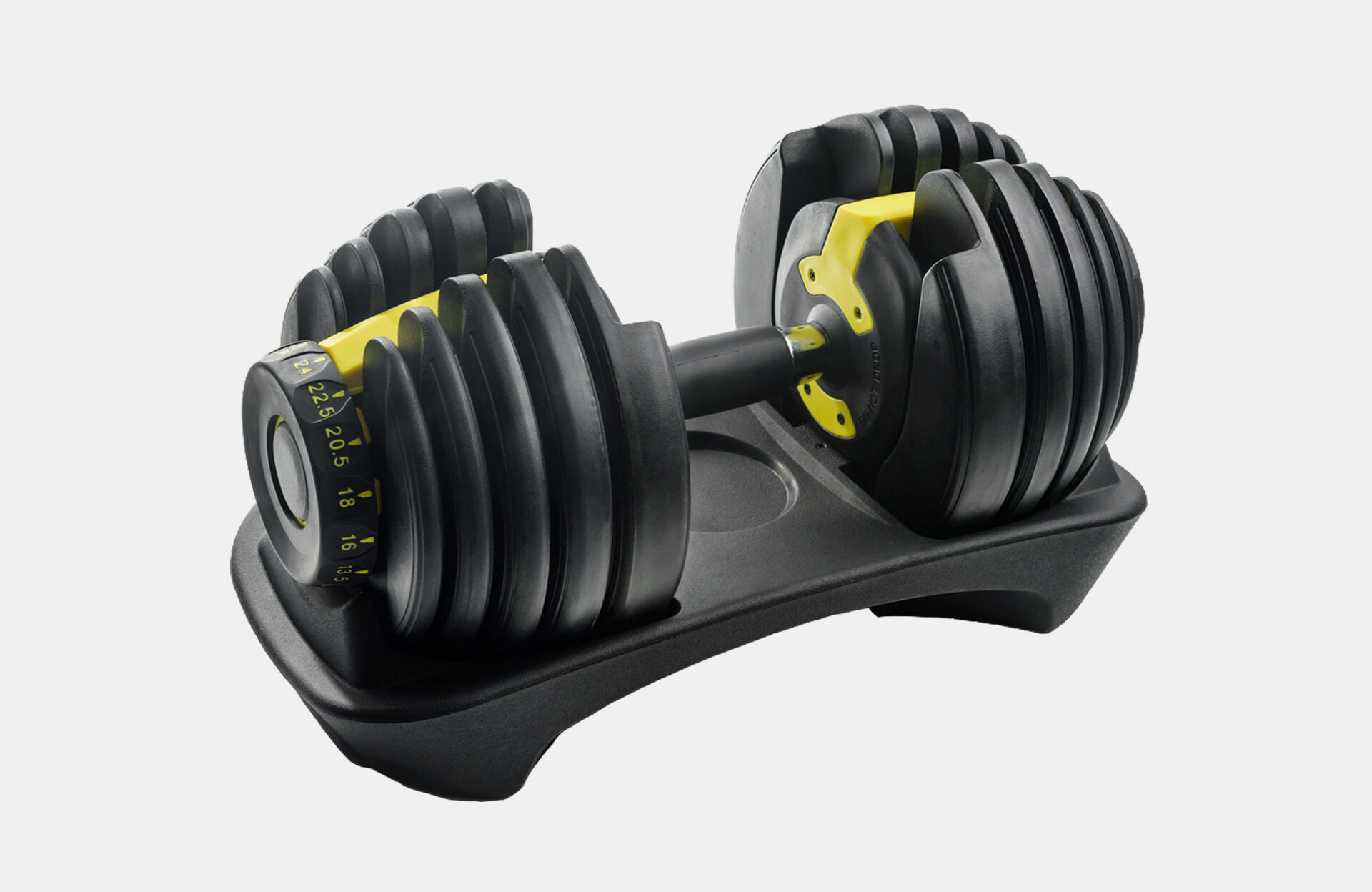
3. Pin
Another construction technique is to use a pin to adjust the weight, similar to how you adjust weights on a weightlifting machine. To change the weight, manually move a pin to set the new weight. There are a few different versions, but the primary function is the same on all of them.
+ fairly quick to change the weight
- cumbersome, the length of the dumbbell is the same (and too long, as it will be in the way during certain movements) regardless of the chosen weight, and the shape of the dumbbell could be unnatural
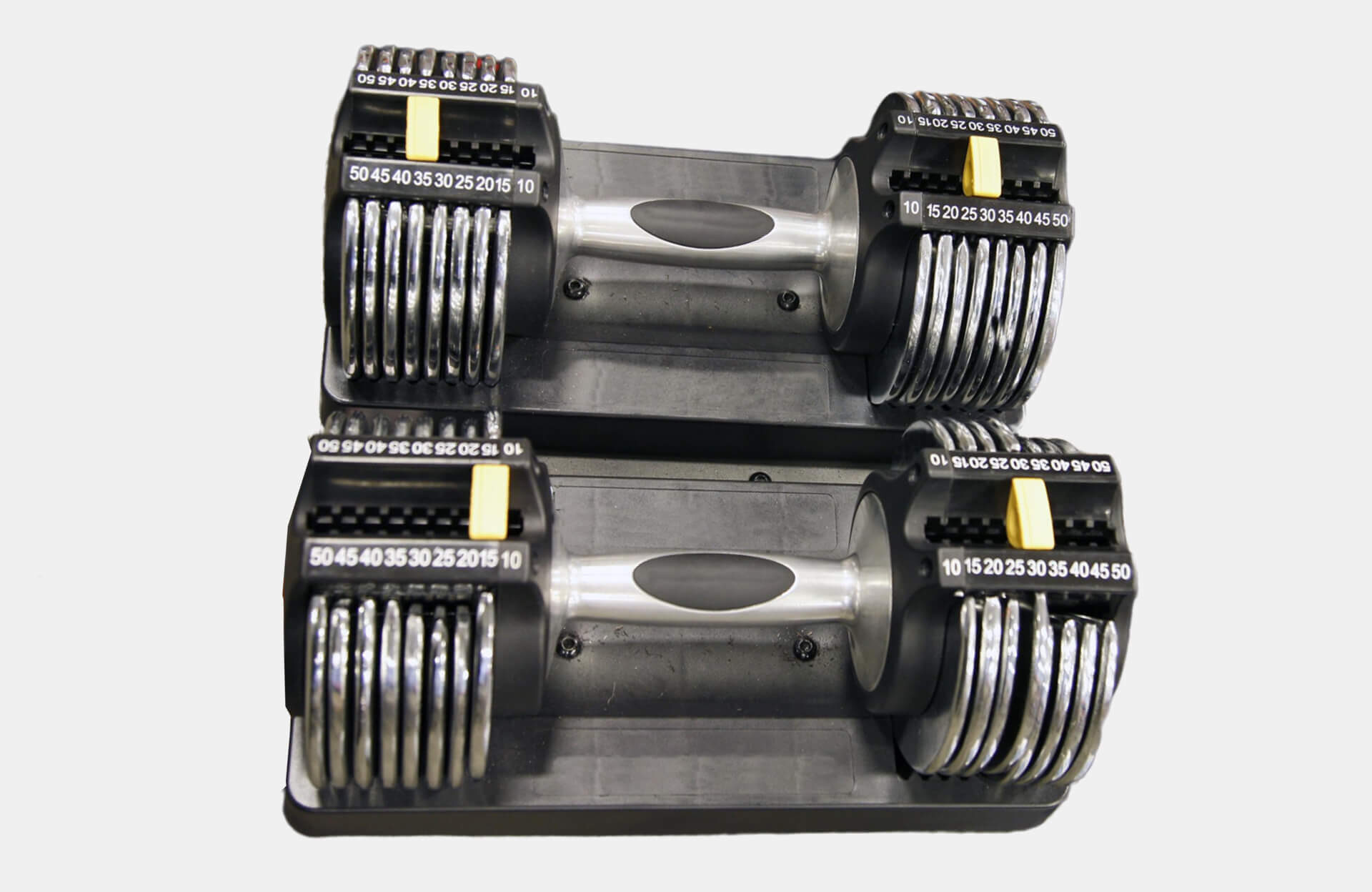
4. Twist and lift
The twist-and-lift dumbbells consist of a bar with equally sized round weight plates and a docking rack.
The construction of the twist and lift version is more advanced than the other alternatives. But from a user perspective, this model is as easy as it gets to use.
As the name implies, you twist the handle to choose your weight and then lift the dumbbell. The weight plates not in use will remain in the docking station. To change the weight, put the dumbbell back in the docking station and choose a new number.
When twisting the handle, the adjustment mechanism in the dumbbell hooks into, or releases, one more plate on each side.
+ compact
+ changes size depending of the chosen weight
+ weight change is fast and easy
+ extremely easy to use
- costs a bit more
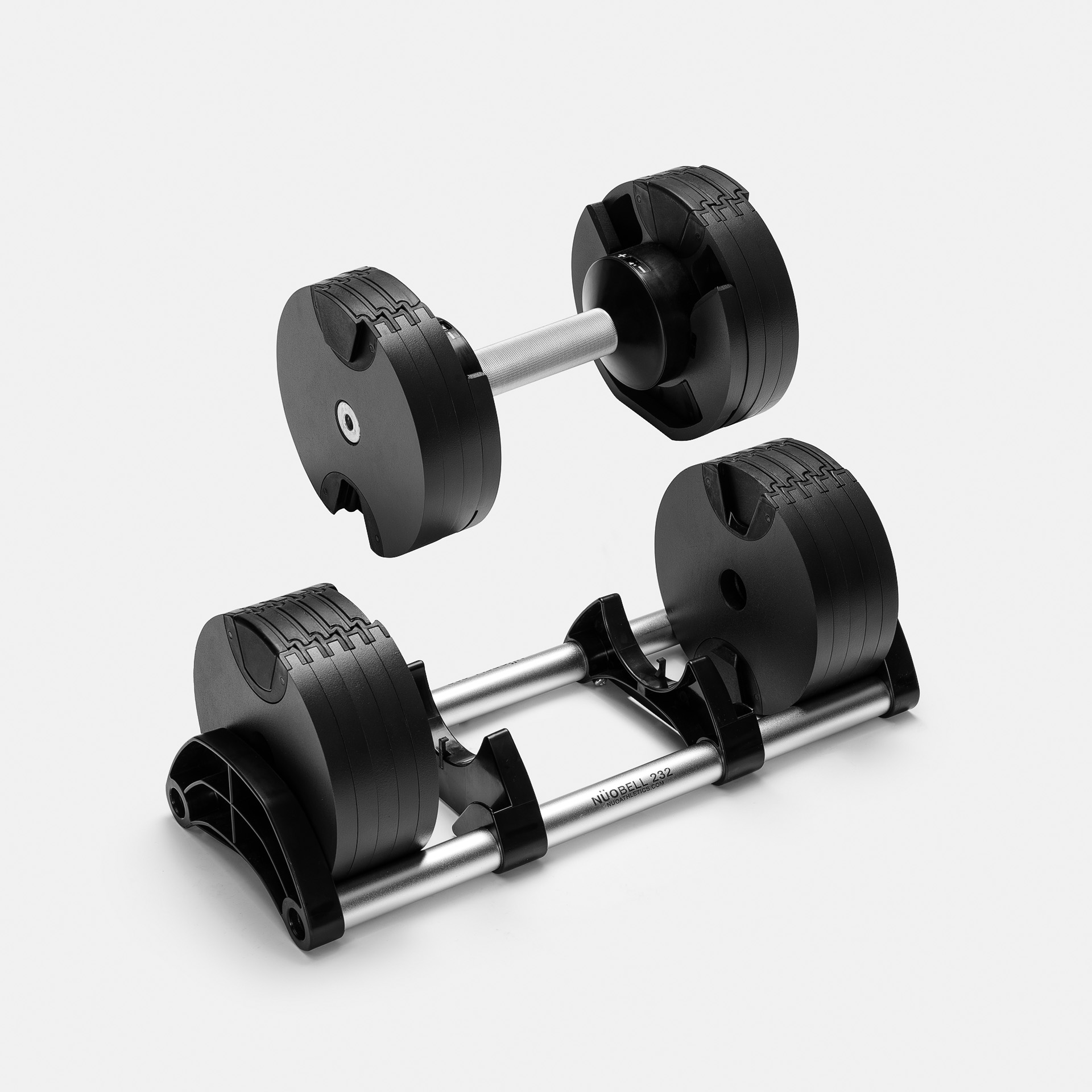
Fixed dumbells
Pros
- Compact, each dumbbell is only as big as it needs to be
- Can be dropped or thrown to the floor
- Just pick the weight you want and go
Cons
- Gets costly quick if you want more weights
- Multiple pairs require a lot of space
- You need to buy more weights as you improve
- Harder to perform super sets
Adjustable dumbbells
Pros
- Save space
- Easy to store
- Many different weight options in one dumbbell
- Saves money compared to buying the equal number of fixed weights
- Portable
Cons
- Can’t be dropped
- Some models can be a bit cumbersome
- Cost a bit more
How much do dumbbells cost
Short answer: it depends! Like anything in life, the dumbbell that is best for you depends on your needs and preferences. For example, do you want to have the possibility to do whole-body workouts or only want to perform a limited set of exercises?
For whole-body workouts, you need a more extensive range of weights.
In general, pairs of fixed dumbbells cost roughly:
2,5 kg = 20 EUR
5 kg = 35 EUR
7,5 kg = 55 EUR
10 kg = 70 EUR
12,5 kg = 90 EUR
15 kg = 110 EUR
40 kg = 300 EUR
10 lbs = $20
15 lbs = $30
20 lbs = $40
25 lbs = $50
30 lbs = $60
The conclusion of the costs of fixed dumbbells is that if you only need a few different pairs of dumbbells, it’s worth buying fixed.
But the cost adds up quickly if you require a full set of fixed dumbbells for complete whole-body workouts, let’s say 10–16 pairs of dumbbells.
Adjustable dumbbells differ significantly in price, but you get what you pay for. The more expensive ones will be more durable, easier to handle, easier and faster to adjust, and offer more weights in the same dumbbell and often in a more convenient shape, without excess bulk.
Price range of adjustable dumbbells is roughly:
100–1000 EUR
In the lower price range, you find the models that require more time to adjust, like the ones you change with knobs on each side. The cheaper ones come with just a few weight options.
In the higher range, the dumbbells have significantly more weight options, roughly 16 different options, starting at 2 kg and upwards toward 35 kg, even up to 40 kg.
How to choose the right dumbbell
For a commercial gym, most of the time, it’s a no-brainer to get fixed dumbbells. But if you want to buy dumbbells for your home training, consider your needs before deciding.
There are a few things to consider when choosing a dumbbell for your home training:
- how much space you have
- the exercises you plan to perform
- your budget (to have a complete range of weights; endless: fixed, restricted; adjustable)
Don’t be too modest when choosing the maximum weight; the goal is to progress and to get stronger you need to be able to “gear up” the weight. Therefore you need enough weight to not out-grow your range, nor to “stop” your progression.
You might consider buying fixed dumbbells if the following is true:
- You need only a few pairs of dumbbells
- You don’t know if dumbbell training is for you, in which case, start with a few pairs and try it out before you invest in a complete range of weights
- You have a lot of space
- You need a complete range of weights, and your budget (and home) has no limits
You might consider buying adjustable dumbbells if the following is true:
- You need many different weights, and you’re on a restricted budget
- Your space is limited, and you love your dog
- You want to perform many different kinds of exercises
- You want to be able to bring your weights with you, whether outdoors or on an extended trip.
.
Final words
Even if you prefer to work out with dumbbells, a mix of other forms of training is crucial to success if you want to be healthy and strong. So don’t forget to do cardio, yoga and other complementary training forms.
There are pros and cons with both fixed and adjustable dumbbells, but if you spend most of your training at home, including strength training and cardio-based HIIT workouts, strongly consider adjustable dumbbells. They offer a wide weight range to suit all your needs for strength training, and when not in use, they can easily be stored in your wardrobe or under your bed.
Adjustable dumbbells offer a great spread of weight in a compact form factor that can easily be tucked in the corner of a room or stashed in the bottom of a wardrobe when not in use. The design of some models might feel a little alien and bulky to seasoned gym-goers, so make sure you pick a model that looks like a regular dumbbell. Where value for money and convenience is concerned, adjustable dumbbells are hard to beat when it comes to the home gym.
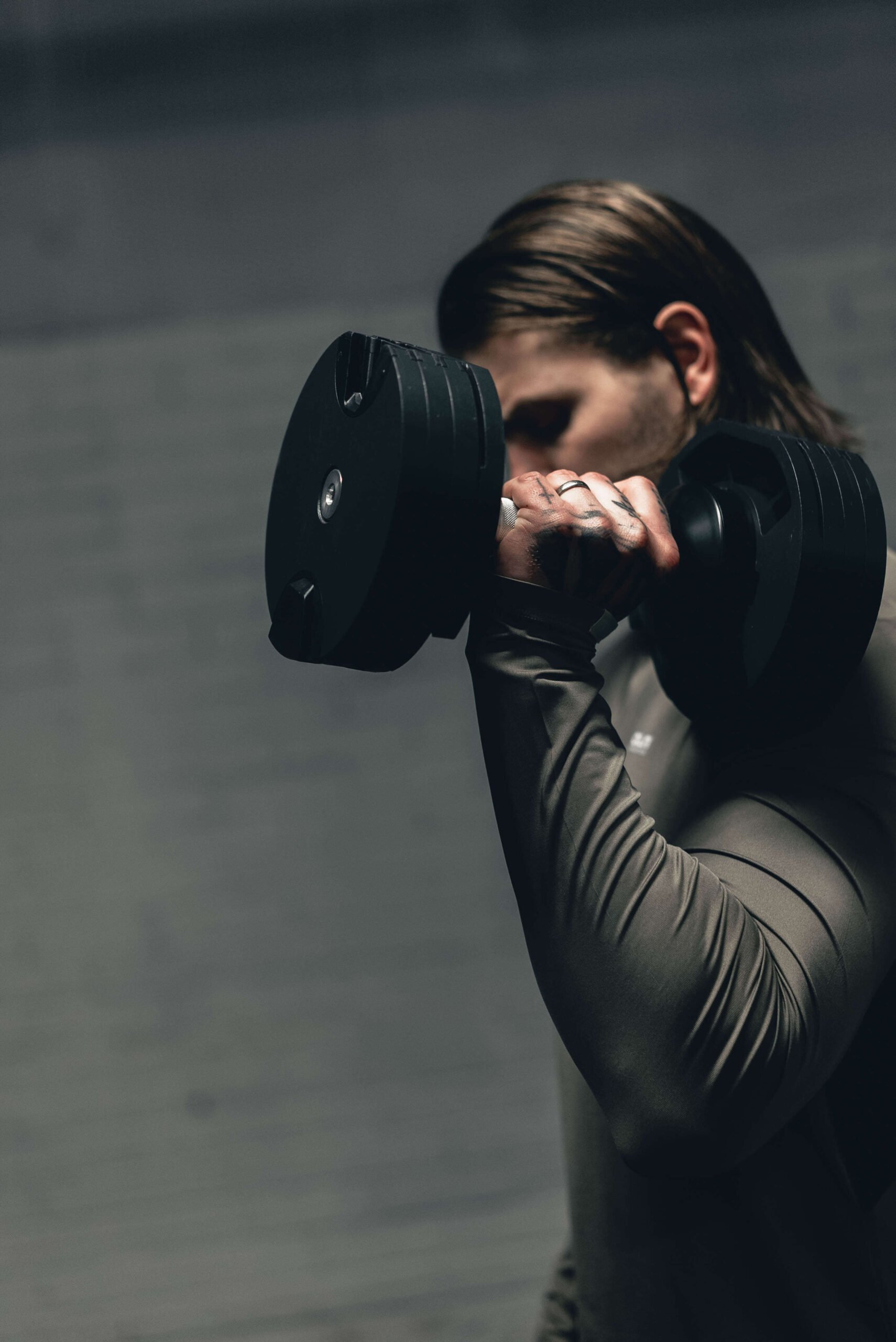
#Bonus tip!
Three common mistakes when training with dumbbells
1.
Using Too Much Weight: Many people make the mistake of using weights that are too heavy for them, which can lead to injury or strain on the muscles. Start with lighter weights and gradually increase the weight as you become stronger.
2.
Poor Form: Poor form is a common mistake when training with dumbbells. Incorrect posture, improper grip, and incorrect range of motion can all lead to injury. Make sure you learn the proper form and technique for each exercise and focus on maintaining it throughout your workout.
3.
Lack of Variation: Many people stick to the same exercises and routine, which can lead to boredom and plateauing. Incorporating different exercises and varying your routine can help prevent boredom and challenge your muscles in new ways.